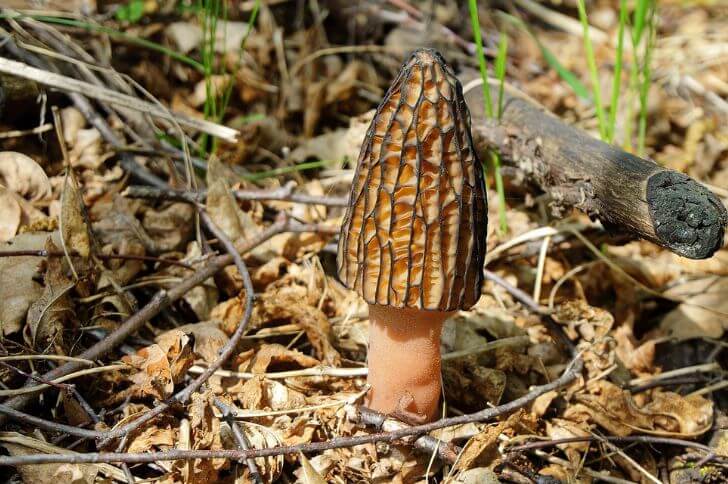Gray mushrooms are a fascinating and enigmatic species that have captured the attention of mycologists and nature enthusiasts alike. With their unique coloration and mysterious presence in various ecosystems around the world, these fungi have sparked curiosity and intrigue.
While they may not possess the vibrant hues commonly associated with other mushroom varieties, their subdued gray appearance holds its own allure. In this article, we will delve into the world of gray mushrooms, exploring their characteristics, ecological significance, and potential uses in human society.
Join us as we uncover the hidden beauty within these understated yet captivating organisms.
List of Gray Mushrooms
1. Oyster Mushrooms

Oyster mushrooms are a popular variety of edible mushrooms that belong to the genus Pleurotus. They are characterized by their unique shape and coloration, with a distinct gray hue that sets them apart from other mushroom species.
Oyster mushrooms got their name due to their resemblance to oysters in terms of appearance and texture.
These versatile fungi can be found growing naturally on dead or decaying wood, particularly on hardwood trees such as oak, birch, and beech. However, they can also thrive in cultivated environments with the right conditions.
Oyster mushrooms have a delicate flavor profile that is often described as mild and slightly sweet. This makes them an ideal ingredient for various culinary dishes, including stir-fries, soups, risottos, and salads.
2. Gray Morels
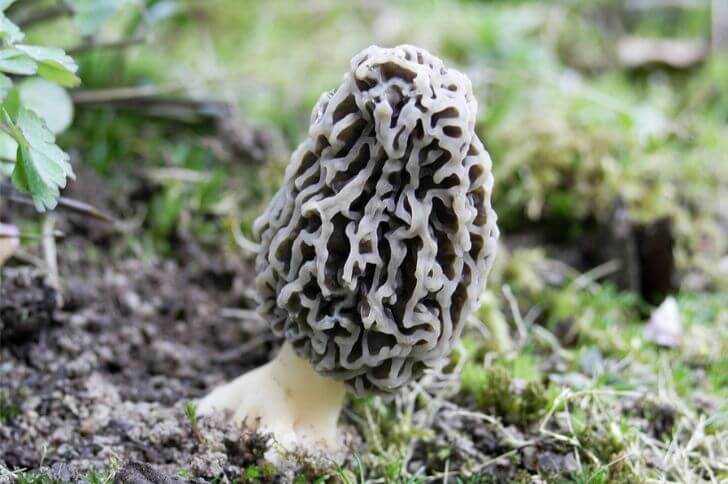
Gray morels, also known as Morchella tomentosa, are a type of mushroom that belongs to the Morchellaceae family. These unique fungi are highly sought after by mushroom enthusiasts and foragers due to their distinctive appearance and exquisite flavor.
Gray morels are characterized by their cone-shaped caps with intricate ridges and pits, giving them a honeycomb-like texture. Their color can vary from pale gray to dark gray or even black, depending on their maturity.
These mushrooms typically emerge in the spring season, often popping up in areas with recently burned vegetation or disturbed soil.
When it comes to culinary use, gray morels are considered a delicacy amongst chefs worldwide. They possess a rich earthy flavor that intensifies when cooked properly.
3. Straw Mushroom
Straw mushrooms, scientifically known as Volvariella volvacea, are a type of edible mushroom characterized by their small size and delicate texture. These gray mushrooms are commonly found in Southeast Asia and are renowned for their mild flavor and unique aroma.
Growing on rice straw beds, they have a distinctive appearance with their egg-like caps.
When properly cooked, straw mushrooms develop a tender and succulent texture that is highly sought after in many Asian cuisines.
Due to their delicate nature, they require gentle handling during preparation to preserve their shape and flavor. With their subtle taste profile, straw mushrooms easily absorb the flavors of other ingredients in dishes such as stir-fries, soups, curries, and noodle preparations.
4. Parasol Mushroom

Parasol mushrooms, scientifically called Macrolepiota procera, are a species of gray mushrooms that belong to the family Agaricaceae.
These impressive fungi can be easily recognized by their large caps that can reach up to 19.6 inches in diameter. The cap starts off oval-shaped when young and expands into a distinctive umbrella-like shape as it matures, hence the name “parasol.”
Underneath the cap, parasol mushrooms have closely spaced gills that start off white but turn pink and sometimes brown as they mature.
They also possess a tall and slender stem that is covered in small scales or flakes, which adds to their unique appearance. Parasol mushrooms are usually found growing in grassy areas such as meadows, pastures, or lawns during late summer and fall.
5. Maitake (Grifola Frondosa)

Maitake, also called the hen-of-the-woods or maitake mushroom, is a fascinating species that belongs to the fungal kingdom. These gray mushrooms are native to China and North America, where they grow in clusters at the base of trees, particularly oak trees.
The name “hen-of-the-woods” originates from its unique appearance resembling a fluffed-up chicken sitting on top of logs or fallen tree trunks.
The distinctive feature of Grifola frondosa lies in its frond-like structure, which consists of multiple overlapping layers resembling feathery leaves.
This mushroom can reach impressive sizes, with some specimens weighing up to 100 pounds. Due to its striking appearance and culinary value, maitake has become a sought-after ingredient in various cuisines around the world.
6. Panaeolus Olivaceus

Panaeolus olivaceus is a species of small gray mushrooms belonging to the family Bolbitiaceae. These mushrooms are characterized by their distinct smoky gray coloration and slender stems. They typically have convex caps that range in size between 0.3-1.57 inches in diameter.
When can you find panaeolus olivaceus? These small grey mushrooms pop out in summer and are common in Georgia, Washington, Oregon, Minnesota, UK and New Zealand.
7. Grooved Bonnet (Mycena polygramma)
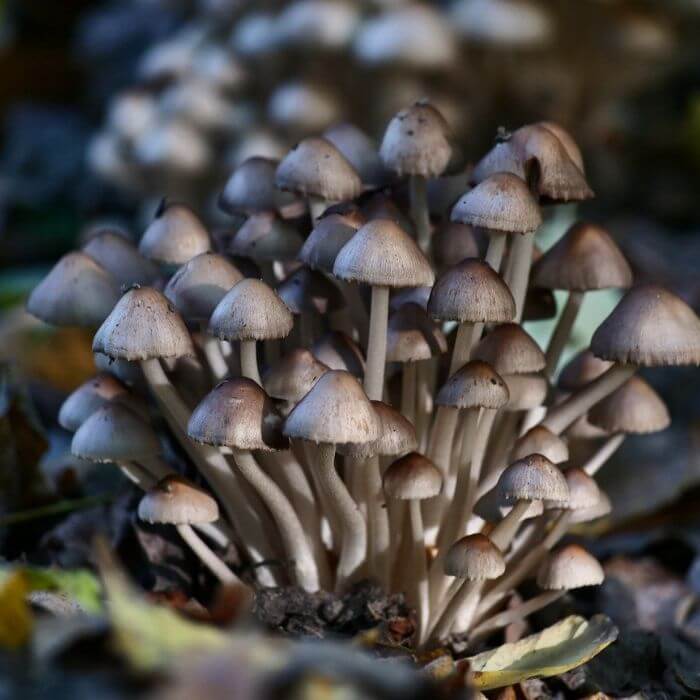
Mycena polygramma or grooved bonnet is a type of gray fungus that belongs to the Mycenaceae family.
This mushroom has a small cap, usually measuring 0.8-1.6 inches in diameter, and its color can vary from pale grayish-white to dark gray. The shape of the cap is conical when young but becomes convex with age.
The gills are closely spaced and are initially whitish before turning pinkish as they mature. Their stem is slim and long, measuring up to 5.9 inches in length.
Also the grooved bonnet is bioluminescent. This small gray-colored mushroom is inedible.
Related read: check different types of spored mushrooms
8. Common inkcap

Gray mushrooms are a common sight in many wooded areas, and one variety that stands out is the Common inkcap. Scientifically known as Coprinopsis atramentaria, this mushroom species belongs to the family Psathyrellaceae.
True to its name, the Common inkcap boasts a distinctive gray coloration on its cap and stem. While it may appear unassuming at first glance, this mushroom holds some fascinating qualities.
One striking characteristic of the common inkcap is its ability to rapidly dissolve into an inky black liquid as it matures. This process is known as deliquescence and occurs when the mushroom produces spores.
As the cap expands and ages, it begins to liquefy from the edges inward, transforming into an inky substance that drips down onto the ground below. These grey mushrooms are edible but avoid alcohol when eating them.
9. Mica Cap (Coprinellus micaceus)

Coprinellus micaceus, also called the mica cap or shiny cap mushroom, is a species of fungus in the family Psathyrellaceae. These mushrooms are characterized by their small to medium size and distinctive appearance.
The caps of Coprinellus micaceus are convex when young but flatten out as they mature, reaching a diameter of 0.5-1 inch. They have a smooth texture and are typically gray or brown in color.
One striking feature of Coprinellus micaceus is the presence of tiny reflective particles on its surface, giving it a shimmering or glistening appearance hence its common name “shiny cap.”
This unique attribute is caused by the accumulation of crystalline substances known as cystidia on the mushroom’s cap.
Another interesting aspect of this species is its rapid growth and decomposition process. The fruit bodies emerge quickly after rainfall and can double in size within just a few days.
Mica caps grow gregariously and are edible.
10. Gem-studded puffball (Lycoperdon perlatum)

Lycoperdon perlatum, commonly known as the gem-studded puffball or warted puffball, is a unique fungus that belongs to the family Agaricaceae. It is characterized by its unique appearance and distinctive features.
The fruiting body starts off round and smooth but gradually becomes covered in spiny projections or warts as it matures. These warts are often brownish or grayish in color and give the mushroom a striking aesthetic appeal.
When it comes to spore dispersal, this puffball releases clouds of powdery brown spores through a small opening at the top, called an ostiole. This process occurs when the outer layer of the mushroom ruptures due to changes in internal pressure caused by raindrops or physical disturbances
As these tiny spores are dispersed into the air, they can be carried over long distances by wind currents, allowing for effective reproduction and colonization.
The gem-studded puffball can typically be found growing on forest floors or open grasslands from late summer to autumn.
They are generally considered edible when young and still white inside.
11. Field’s Bird Nest (cyathus olla)
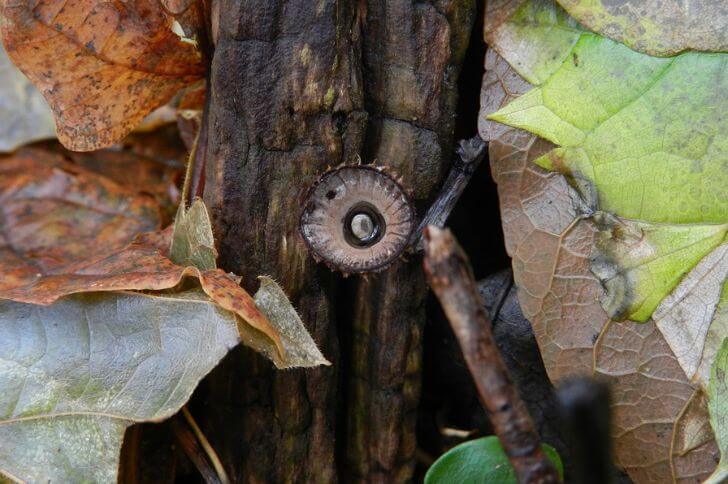
Field’s bird nests are a type of unique gray fungi found all over Europe and North America. What sets this mushroom apart from others is its unique reproductive strategy.
Instead of producing spores directly on its surface like most mushrooms, this bird nest species has evolved small cup-shaped structures resembling miniature bird nests. These tiny cups contain even tinier eggs – the spore capsules that will eventually be dispersed by passing raindrops or animals brushing against the fungus.
The bird’s nest fungi serve as nature’s clever tricksters, luring insects and other small creatures to their nests with a tantalizing scent reminiscent of decaying organic matter. Once inside, these unwitting visitors become potential carriers for the fungal spores, as they inadvertently pick up and transport them to new locations.
This complex relationship between the bird’s nest fungi and their unsuspecting guests showcases nature’s ingenuity in coevolutionary adaptations.
12. Gray Shag (Coprinopsis cinerea)
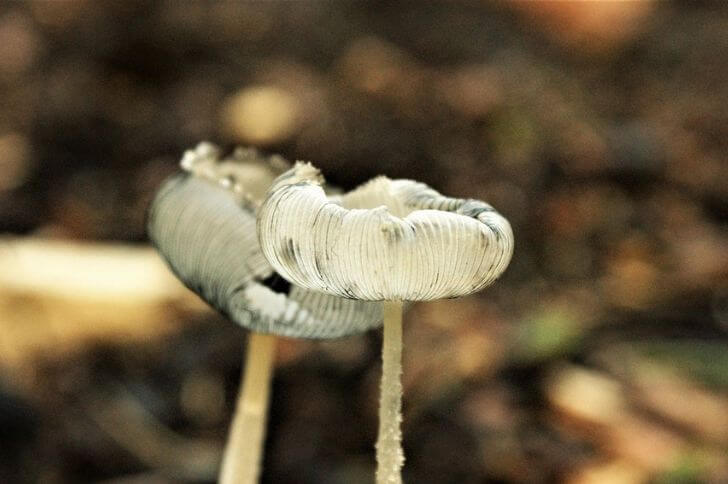
Coprinopsis cinerea, colloquial name gray shag, is a unique species that offers both beauty and mystery. Found in abundance throughout North America and Europe, these mushrooms are often seen emerging from decaying organic matter such as rotting logs or compost heaps.
With their distinct gray cap and slender white stem, they might appear like any other common mushroom at first glance. However, their true fascination lies in their biology and life cycle.
One fascinating aspect of Coprinopsis cinerea is its rapid growth rate. These mushrooms can emerge overnight and reach maturity within hours.
This process is so swift that you could almost watch it happen before your eyes! It starts with small button-like structures that expand rapidly into larger buttons before unfurling their cap to release spores – an essential mechanism for reproduction and dispersion.
Furthermore, the lifecycle of Coprinopsis cinerea has an intriguing twist known as autodigestion or self-digestion.
As the gills beneath its cap mature in preparation for releasing spores, they gradually break down into a black liquid containing enzymes that aid in spore dispersal. This highly efficient process ensures maximum chances of success for this remarkable species.
13. Mossy Maze Polypore

The mossy maze polypore is a fascinating species that often goes unnoticed in our forests. With its striking grey color and intricate maze-like pattern on its cap, it adds a touch of mystery to any woodland setting.
This unique fungus can be found growing sugar maples and some species of birch trees, causing rot and decay.
What makes the mossy maze polypore truly intriguing is its survival strategy. Unlike many other mushrooms that rely on spores for reproduction, this species can also reproduce asexually through fragmentation of its mycelium network.
As portions of the fungus break off and spread throughout the forest floor, new colonies of grey mushrooms can quickly form. This adaptive ability ensures their presence in various habitats and contributes to their reputation as one of nature’s resilient organisms.
14. Clouded Agaric (clitocybe nebularis)

Clitocybe nebularis, also known as the Clouded Funnel or clouded agaric, is a captivating species of mushroom found in deciduous forests.
With its unique grayish cap and funnel-like shape, this mushroom stands out among its fellow fungi. While it is considered edible, experts recommend avoiding it.
15. Tinder Fungus (fomes fomentarius)
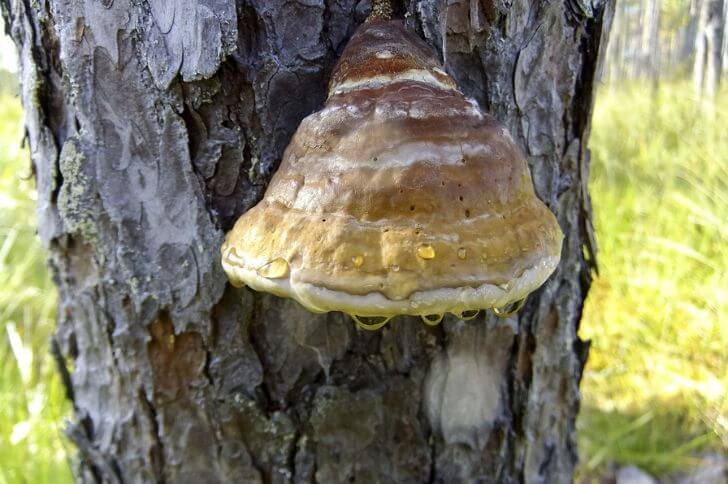
Tinder fungus, scientifically known as fomes fomentarius, possesses a captivating history and numerous intriguing properties. This species of mushroom has been employed for centuries due to its ability to create fire using friction.
In fact, ancient people would peel off the outer layer of the fungus and then strike it with stones to generate sparks that ignited dry tinder. This unique trait granted humans the power to control one of nature’s most primal forces — fire — shaping civilizations across time.
Beyond its usefulness in fire-starting, this gray shelf mushroom has also proven itself valuable in traditional practices. Some cultures believed that this mushroom possessed numerous benefits when applied as a poultice or brewed into teas.
16. Umbrella Polypore (polyporus umbellatus)
The polyporus umbellatus, also called umbrella polypore, is an interesting member of the mushroom kingdom. Its distinctive gray cap and its tendency to grow in tight clusters make it an eye-catching sight in the forest.
Final Thoughts:
In conclusion, gray mushrooms are a fascinating and often overlooked component of the fungal world. Despite their drab appearance, they play a crucial role in various ecosystems, from decomposing organic matter to forming symbiotic relationships with plants.
Their ability to adapt and thrive in diverse environments is a testament to the resilience of nature. As we continue to explore and study these mysterious organisms, it is important to appreciate their significance and strive for their conservation.
Let us not underestimate the power of gray mushrooms and the vital role they play in maintaining the balance of our natural world.
source:
Hi There,
My name is Jenny. I’m the Chief Editor at Try Green Recipes and besides making yummy and healthy foods for my kids, grandkids, and friends. I’m new to the blogging world but I believe what I have to share is unique and will bring joy to your home. If you are adventurous and want try something tasty, let’s get started.

